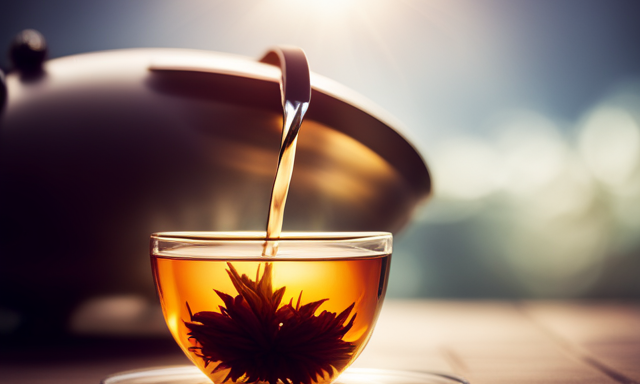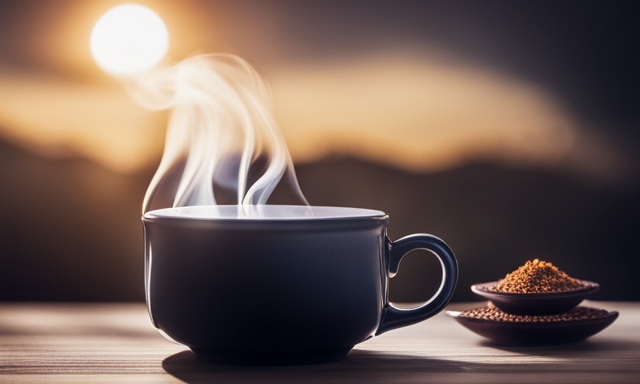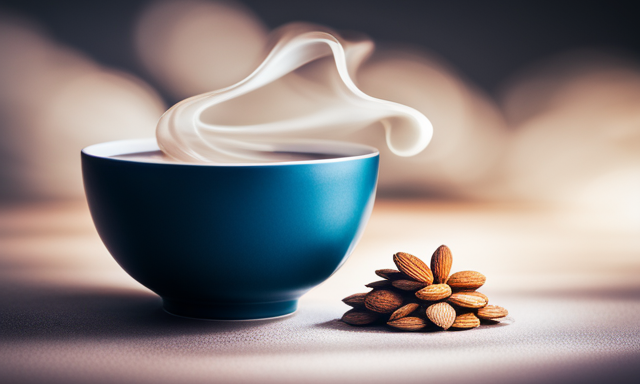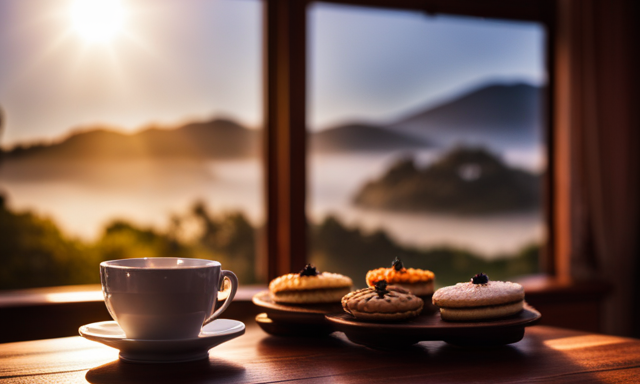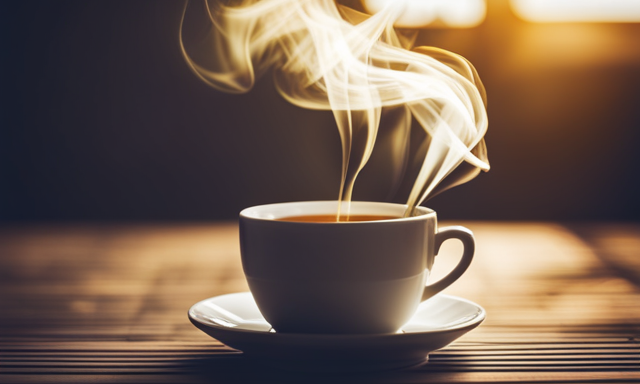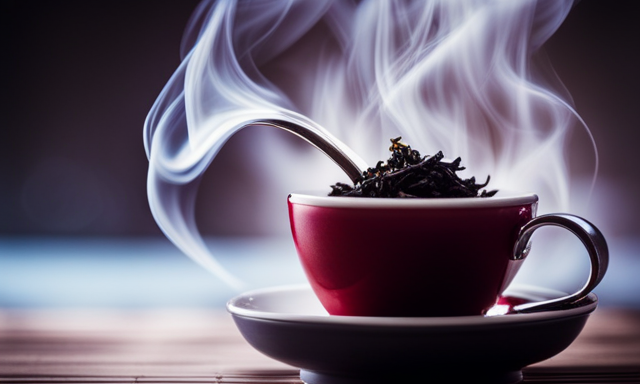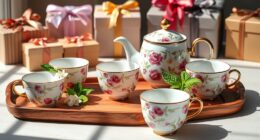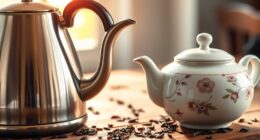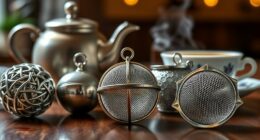Coincidentally stumbling upon the exquisite world of oolong tea was like discovering a hidden treasure within my teacup. Allow me to guide you through the art of serving this beloved beverage, as if we were sharing a pot of oolong tea together. As a tea enthusiast and self-proclaimed oolong aficionado, I am thrilled to impart my knowledge and passion for this captivating tea.
In this article, we will embark on a journey to uncover the history and origins of oolong tea, explore the various types and their unique characteristics, and delve into the precise techniques that elevate the tea-drinking experience. From selecting the finest oolong leaves to preparing the perfect teapot and tea set, we will leave no stone unturned. We will discuss the ideal water temperature, steeping time, and brewing methods that will unlock the true essence of oolong tea.
So, sit back, relax, and let me be your guide in the enchanting world of oolong tea. Together, we will discover the flavors, aromas, and cultural significance that make oolong tea a truly remarkable beverage.
Key Takeaways
- Cold brewing oolong tea involves steeping tea leaves in cold water in the refrigerator for at least 4 hours.
- Enhance the flavor of oolong tea by adding citrus slices, mint leaves, or a touch of honey.
- Oolong tea pairs well with light salads, seafood, and grilled vegetables.
- Properly store oolong tea in a cool, dark place in an airtight container made of ceramic or glass to maintain freshness and quality.
History and Origins of Oolong Tea
So, you’re curious about the history and origins of oolong tea, huh? Well, let me take you on a fascinating journey through time to uncover the rich heritage and cultural significance behind this beloved beverage.
Oolong tea has a long and storied history, dating back centuries to ancient China. Legend has it that the name ‘oolong’ translates to ‘black dragon,’ a fitting moniker for a tea with such remarkable flavor and complexity. The precise origins of oolong tea are shrouded in mystery, but it is believed to have been first cultivated in the Fujian province.
In terms of health benefits, oolong tea is renowned for its potential to boost metabolism and aid in weight management, thanks to its high concentration of antioxidants. Additionally, it may help lower cholesterol levels and promote heart health. Rich in vitamins and minerals, oolong tea is a refreshing and nourishing beverage that has stood the test of time.
Now that you have a deeper understanding of the history and health benefits of oolong tea, let’s delve into the next exciting topic – choosing the right oolong tea leaves.
Choosing the Right Oolong Tea Leaves
To choose the ideal oolong tea leaves for your brewing pleasure, you should meticulously examine the various options available. Consider factors such as leaf appearance, aroma, and origin. Oolong tea offers a diverse range of flavor profiles, ranging from light and floral to rich and roasted. This variety ensures that there is a taste to suit different preferences. Oolong tea also boasts numerous health benefits, including boosting metabolism, promoting heart health, and aiding digestion. Oolong tea is primarily produced in China and Taiwan. Each region offers its own unique terroir and cultivation methods that contribute to the tea’s distinct characteristics. As a tea sommelier, I recommend exploring different types of oolong tea to discover your personal favorite flavor profile and experience the various health benefits associated with this remarkable beverage.
Now, let’s move on to preparing your teapot and tea set.
Preparing Your Teapot and Tea Set
Begin by carefully arranging your teapot and tea set. Ensure that each piece is clean and in its proper place.
To prepare your oolong tea leaves, measure the desired amount and place them in a tea infuser or directly into the teapot.
Next, select a teapot that is suitable for oolong tea. Porcelain or clay teapots are often recommended, as they retain heat well and enhance the flavor of the tea.
Make sure to preheat the teapot by rinsing it with hot water, then discard the water. This step helps to maintain the optimal temperature during steeping.
Once your teapot and tea leaves are ready, you can proceed to the next section about proper water temperature and steeping time.
Proper Water Temperature and Steeping Time
To achieve the perfect steeping for oolong tea, follow these guidelines:
-
Water Temperature: Brew oolong tea with water around 190-200°F (88-93°C). This helps the leaves unfurl slowly and release their flavors.
-
Infusion Time: Steep oolong tea for 3-5 minutes, adjusting according to your preference and the specific tea.
-
Teaware: Use a porcelain or ceramic teapot that retains heat well for the best oolong tea experience. This keeps the water temperature consistent.
-
Tea-to-Water Ratio: Use approximately 1 teaspoon of loose oolong tea per 8 ounces of water. Adjust to your desired strength.
-
Experiment and Enjoy: Oolong tea offers a wide range of flavors and aromas. Feel free to experiment with different water temperatures and infusion times to find your perfect cup.
Now that you know the proper way to steep oolong tea, let’s explore the various brewing techniques for this exquisite tea.
Brewing Techniques for Oolong Tea
Get ready to embark on a journey of flavor as you discover the art of brewing oolong tea using various techniques that will elevate your tea-drinking experience. As a tea sommelier, I am passionate about sharing my knowledge and enthusiasm for oolong tea. To improve the flavor of your oolong tea, it is important to use the proper brewing techniques. Here is a table that will guide you through the process:
| Brewing Technique | Water Temperature | Steeping Time |
|---|---|---|
| Gongfu | 195°F (90°C) | 1-2 minutes |
| Western | 185°F (85°C) | 3-5 minutes |
| Cold Brew | Cold water | 4-8 hours |
By using these brewing techniques, you can enhance the unique flavor profiles of different oolong tea varieties. Additionally, oolong tea offers numerous health benefits, such as aiding in weight loss, improving heart health, and boosting mental alertness. Now, let’s explore how to further enhance the flavor of your oolong tea with tea accessories.
Enhancing the Flavor with Tea Accessories
To truly elevate your oolong tea experience, consider using tea accessories. A glass teapot can showcase the beautiful color of the steeped leaves, while a tea timer ensures the perfect infusion every time. Imagine sitting down with your favorite book, sipping on a warm cup of oolong brewed in a delicate glass teapot, and feeling a sense of tranquility wash over you.
Here are four tea accessories that can enhance the flavor of your oolong tea:
- A tea infuser: Use a fine mesh infuser to prevent any loose tea leaves from floating in your cup.
- Tea tongs: These handy tools make it easy to handle hot teacups and teapots without burning your fingers.
- A tea whisk: For matcha oolong tea, a bamboo whisk can help create a frothy and smooth texture.
- A tea cozy: Keep your teapot warm and maintain the optimal temperature for a longer brewing time.
Using these tea accessories will not only enhance the flavor of your oolong tea but also make the brewing process more enjoyable.
Now, let’s move on to serving oolong tea hot.
Serving Oolong Tea Hot
Indulge in the comforting warmth of a perfectly steeped cup of fragrant oolong, inviting you to savor each sip and embrace the soothing sensation it brings. To serve oolong tea hot, start by heating water to the ideal temperature of 190-200°F (88-93°C). This range ensures the tea leaves release their full flavor without becoming bitter. Measure one teaspoon of oolong tea leaves per cup and place them in a teapot. Pour the hot water over the leaves and let them steep for 2-3 minutes. The steeping time can be adjusted depending on your preference for a stronger or milder brew. Once the tea is ready, pour it into teacups and enjoy the rich, complex flavors of oolong tea. The benefits of drinking hot oolong tea include improved digestion, increased metabolism, and a boost in mental alertness. Transitioning into the subsequent section about serving oolong tea cold, let’s explore another refreshing way to enjoy this versatile beverage.
Serving Oolong Tea Cold
Chilling out with a perfectly brewed cup of cold oolong is the ultimate way to beat the summer heat. To serve oolong tea cold, start by cold brewing it.
Add oolong tea leaves to a jug or pitcher and fill it with cold water. Let it steep in the refrigerator for at least 4 hours or overnight for a stronger flavor.
When ready to serve, strain the tea to remove the leaves. The ideal water temperature for cold brewing is around 40-50°F. The steeping time can vary depending on personal preference, but 4-6 hours is a good starting point.
To enhance the flavor and enjoy the health benefits of oolong tea, you can add citrus slices, mint leaves, or a touch of honey. Cold-brewed oolong tea is refreshing, crisp, and has a slightly sweet taste.
It pairs well with light salads, seafood, and grilled vegetables. Now, let’s explore how to pair oolong tea with food.
Pairing Oolong Tea with Food
When it comes to pairing oolong tea with food, the possibilities are endless. Oolong tea’s unique flavor profile, which can range from fruity to floral to toasty, makes it a versatile companion for a variety of dishes.
For a light and refreshing pairing, I recommend serving a floral oolong tea with a fresh fruit salad or a light seafood dish. The delicate flavors of the tea will complement the natural sweetness of the fruits or the subtle flavors of the seafood.
If you’re in the mood for something richer and more indulgent, try pairing a roasted oolong tea with a rich chocolate dessert or a savory roasted meat dish. The toasty notes of the tea will add depth and complexity to the flavors of the food.
Additionally, oolong tea is known for its many health benefits, including promoting digestion, boosting metabolism, and improving mental alertness. So not only will you be enjoying a delicious pairing, but you’ll also be nourishing your body.
Now that you know how to pair oolong tea with food, let’s move on to the next section about tips for storing and preserving oolong tea.
Tips for Storing and Preserving Oolong Tea
To keep your precious oolong tea at its peak, treat it like a treasure chest and store it in a cool, dark place away from any air thieves that could spoil its exquisite flavors.
Storing oolong tea properly is crucial to maintain its freshness and quality. The best method is to transfer the tea leaves into an airtight container, preferably made of ceramic or glass, to protect it from moisture and light. Avoid using plastic or metal containers as they can affect the tea’s flavor.
Additionally, it is important to keep the tea away from strong odors, as it can absorb them easily.
To ensure freshness, check for indicators like vibrant color and fragrant aroma. If the tea leaves appear dull or have a stale scent, it might be time to replenish your supply.
By following these storing methods and freshness indicators, you can enjoy the full flavors of oolong tea for a longer period of time.
Frequently Asked Questions
How long should I steep oolong tea to get the best flavor?
To get the best flavor from oolong tea, steep it for 3-5 minutes. This will ensure a balanced flavor intensity without any bitterness. Experiment with different steeping times to find your preferred taste.
Can I reuse oolong tea leaves for multiple infusions?
Yes, you can definitely reuse oolong tea leaves for multiple infusions. By using proper oolong tea infusion techniques, such as adjusting steeping time and water temperature, you can enjoy several flavorful cups from the same leaves.
What are the health benefits of drinking oolong tea?
Drinking oolong tea offers numerous health benefits like aiding weight loss and promoting skin health. Its unique flavor profiles, cultural significance, and origins make it a delightful and enriching tea to enjoy.
Can I add milk or sweeteners to oolong tea?
Yes, you can add milk or sweeteners to oolong tea. However, it is important to note that oolong tea has different flavor profiles, so it is recommended to taste it first before adding anything.
How does the caffeine content in oolong tea compare to other types of tea?
Compared to other types of tea, oolong tea has a moderate caffeine content. It offers various health benefits, such as boosting metabolism and aiding digestion. As a tea expert, I can provide detailed information on oolong tea’s caffeine content and its positive effects on health.
Conclusion
In conclusion, serving oolong tea requires attention to detail and a passion for this exquisite beverage. As a tea sommelier, I have shared my knowledge and expertise on the history, preparation, and serving of oolong tea.
I have guided you in choosing the right leaves, preparing the teapot, and selecting the ideal water temperature and steeping time.
I have also emphasized the importance of using proper teaware and provided tips for storing and preserving oolong tea.
Through my precise and detailed instructions, I hope to have inspired you to explore the world of oolong tea and appreciate its unique flavors and health benefits.
So, steep your tea, savor the aroma, and let the delicate flavors dance on your palate like a harmonious symphony.

